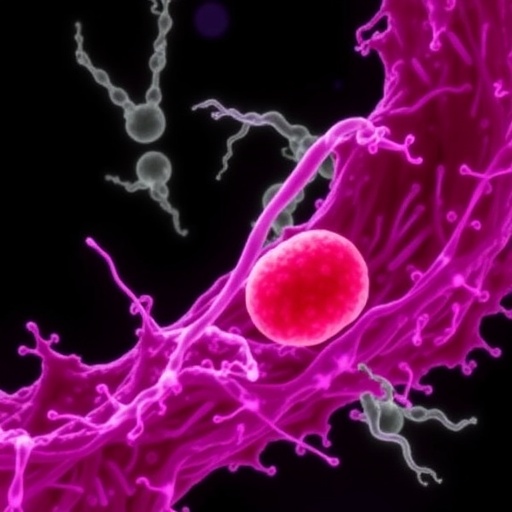
Recent advancements in the field of epigenetics have illuminated the significant role of the Polycomb Repressive Complex 2 (PRC2), a vital regulator of gene expression through chromatin remodeling. At the heart of this complex lies a pivotal interaction between the embryonic ectoderm development (EED) protein and the enhancer of zeste homolog 2 (EZH2). This interaction is not only essential for the proper functioning of PRC2 but also represents a promising target for therapeutic interventions. Researchers are increasingly turning their attention towards the development of small peptides designed to inhibit this particular protein-protein interaction, with the potential to revolutionize treatments for various diseases, including cancer.
The research led by Kundil, Suresh, and Chellappan embarks on a journey to explore the druggability of these small peptides as inhibitors of the EED-EZH2 interaction. By assessing how these peptides can effectively disrupt the binding and subsequent functions of the PRC2 complex, the researchers aim to unveil new therapeutic modalities that could lead to enhanced treatment strategies. Achieving a deeper understanding of the mechanisms governing these interactions is crucial for developing effective inhibitors that do not disrupt other essential biological processes.
In their study, the researchers performed a comprehensive analysis of various small peptides, utilizing advanced computational and experimental methods to predict and validate their potential as inhibitors. The methods employed included molecular docking simulations, binding affinity calculations, and biochemical assays that help ascertain the efficacy of each peptide in interfering with the EED-EZH2 binding process. Through these rigorous assessments, the researchers could hone in on promising candidates that exhibited strong inhibitory properties.
Importantly, the characterization of the small peptides involved elucidating their structural and functional attributes, providing insight into how specific amino acid sequences contributed to their ability to mimic or block the native EED-EZH2 interactions. This foundational knowledge is vital for understanding the interplay between peptide design and biological context, guiding future modifications to enhance the efficacy and specificity of the inhibitors developed.
In addition to the structural studies, the research underscores the necessity of exploring the biological implications of inhibiting the EED-EZH2 interaction. Given PRC2’s multifaceted role in regulating gene silencing and maintaining cellular identity, any therapeutic approach targeting this complex must weigh the risks of unintended consequences. The potential benefits of effective EED-EZH2 inhibitors could range from mechanisms that thwart tumor progression to guiding differentiation processes in regenerative medicine.
Notably, the therapeutic implications of this work extend beyond oncology. The modulation of epigenetic regulation opens avenues for addressing a host of diseases characterized by dysregulated gene expression profiles. For example, conditions such as neurodegenerative diseases, where epigenetic alterations contribute to pathogenesis, could benefit from innovative strategies based on the insights gained from targeting the EED-EZH2 interaction.
The study’s findings also contribute to a growing catalog of small molecule and peptide inhibitors designed to target protein-protein interactions, a historically challenging area in drug development. The success of these inhibitors may hinge on the delicate balance between efficacy and selectivity, posing both a challenge and an opportunity for innovative drug design. As pharmaceutical science continues to evolve, the integration of peptide-based inhibitors into the therapeutic landscape could emerge as a game-changing prospect.
In a world increasingly reliant on precision medicine, the ability to selectively modulate specific protein interactions will be paramount. The extensive analyses conducted in assessing small peptides as inhibitors provide a compelling roadmap for future research endeavors. This will push the boundaries of our understanding of protein functions and interactions, potentially leading to the emergence of advanced therapeutic agents tailored to individual patient profiles.
With the advent of high-throughput screening technologies and sophisticated computational capabilities, the pace of discovery in the realm of protein-protein interactions is accelerating. As researchers build on the findings reported by Kundil and colleagues, the potential for translating these basic scientific insights into clinical applications grows exponentially. Indeed, the goal of realizing a new generation of drugs that can selectively target pathological processes at the molecular level is inching closer to reality.
In conclusion, the research highlighting the druggability of small peptides as inhibitors of the EED-EZH2 interaction sheds light on a critical component of epigenetic regulation. As the scientific community continues to decipher the complexities of protein interactions, the promise of these small peptides as therapeutic agents signifies a pivotal advancement in drug discovery. Future investigations will undoubtedly refine our understanding and harness the therapeutic potential of targeting such critical pathways.
By delving into the intricate world of protein-protein interactions, the research team has laid a significant foundation for developing novel inhibitors that could affect a wide array of diseases linked to the dysfunction of epigenetic mechanisms. As we anticipate the follow-up studies and clinical validation, one thing is certain: the journey to unraveling the complexities of molecular interactions in health and disease is just beginning. The era of targeting the epigenetic landscape with precision is on the horizon, and the implications for human health could be profound.
With this exciting research at our fingertips, the next steps will be crucial to bring these findings from the laboratory into therapeutic contexts, pushing the field of epigenetic drug development into new territories.
Subject of Research: Small peptides as proteinâprotein interaction inhibitors targeting EED-EZH2 binding within the Polycomb Repressive Complex 2 (PRC2)
Article Title: Druggability assessments of small peptides as proteinâprotein interaction inhibitors targeting EED-EZH2 binding within the Polycomb Repressive Complex 2 (PRC2), an epigenetic regulator.
Article References:
Kundil, V.T., Suresh, S.C., Chellappan, S. et al. Druggability assessments of small peptides as proteinâprotein interaction inhibitors targeting EED-EZH2 binding within the Polycomb Repressive Complex 2 (PRC2), an epigenetic regulator. Mol Divers (2025). https://doi.org/10.1007/s11030-025-11321-4
Image Credits: AI Generated
DOI: 10.1007/s11030-025-11321-4
Keywords: EED-EZH2 interaction, small peptides, PRC2, protein-protein interaction, druggability assessments, epigenetics, therapeutic interventions, cancer research.
Tags: advancements in epigenetic drug designcomputational analysis of peptide efficacydrug discovery for gene expression regulationEED-EZH2 interaction inhibitorsepigenetic modulation strategiesinnovative treatments for gene regulation disordersmechanisms of chromatin remodelingpeptide-based inhibitors in epigeneticsPolycomb Repressive Complex 2 researchsmall peptides in cancer therapytargeting protein-protein interactions in cancertherapeutic interventions for epigenetic diseases




